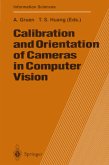This book features representative work in the design of panoramic image capturing systems, the theory involved in the imaging process, and applications that use panoramic images. The intended audience is anyone who wishes to become familiar with panoramic vision and its latest research work. The contents of this book allow the reader to understand the more technical aspects of panoramic vision, such as sensor design and imaging techniques. Researchers, instructors, and students will especially find this book useful.
Current cameras are poor imitations of the human eye and close descen dants in their design of ideas and a technology that are more than a century old. People in computer vision have traditionally used off-the-shelf cameras that were not meant for the uses they were intended for by these researchers: off-the-shelf cameras are designed to capture images to be printed on paper or looked at on a television screen, not for guiding robots or making 3D models of the environment or even surveilling a large area where very large field of views, high geometric and photometric accuracies are necessary. Quite a significant part of the efforts in computer vision has been targeted at overcoming algorithmically these problems. The authors of this book convince us that it is possible to abandon the traditional route of using standard cameras and to follow the path of designing new cameras explicitly for solving the tasks at hand in computer vision applications. This leads to different design concepts and allows to alleviate many of the difficulties encountered in the processing of the images taken with the "traditional" cameras.
Current cameras are poor imitations of the human eye and close descen dants in their design of ideas and a technology that are more than a century old. People in computer vision have traditionally used off-the-shelf cameras that were not meant for the uses they were intended for by these researchers: off-the-shelf cameras are designed to capture images to be printed on paper or looked at on a television screen, not for guiding robots or making 3D models of the environment or even surveilling a large area where very large field of views, high geometric and photometric accuracies are necessary. Quite a significant part of the efforts in computer vision has been targeted at overcoming algorithmically these problems. The authors of this book convince us that it is possible to abandon the traditional route of using standard cameras and to follow the path of designing new cameras explicitly for solving the tasks at hand in computer vision applications. This leads to different design concepts and allows to alleviate many of the difficulties encountered in the processing of the images taken with the "traditional" cameras.
From the reviews:
"I first congratulate the authors for the efforts they have done to explain with great detail and easy language such a complex argument as panoramic vision. ... This book is a good 'database' of arguments on theoretical and practical aspects of panoramic vision. In fact, both algorithmic and implementation items are treated with great accuracy ... . The book has been written by many authors yet the chapters present homogeneity and good coordination in exposing different arguments." (Nello Balossino, The Computer Journal, Vol. 45 (6), 2002)
"This book presents the rebirth of panoramic vision as it is applied to computer vision. It focuses on the creation and analysis of images with fields of view that are much greater than those obtained from typical cameras. ... Overall, this is an informative and coherent reference text that provides details of current research in this field. It is suitable for researchers and professionals involved with computer vision, virtual reality, teleconferencing, imaging systems, and robotics." (The Industrial Robot, Vol. 29 (2), 2002)
"I first congratulate the authors for the efforts they have done to explain with great detail and easy language such a complex argument as panoramic vision. ... This book is a good 'database' of arguments on theoretical and practical aspects of panoramic vision. In fact, both algorithmic and implementation items are treated with great accuracy ... . The book has been written by many authors yet the chapters present homogeneity and good coordination in exposing different arguments." (Nello Balossino, The Computer Journal, Vol. 45 (6), 2002)
"This book presents the rebirth of panoramic vision as it is applied to computer vision. It focuses on the creation and analysis of images with fields of view that are much greater than those obtained from typical cameras. ... Overall, this is an informative and coherent reference text that provides details of current research in this field. It is suitable for researchers and professionals involved with computer vision, virtual reality, teleconferencing, imaging systems, and robotics." (The Industrial Robot, Vol. 29 (2), 2002)








